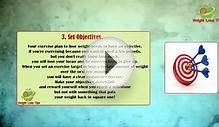
If your goal is permanent fat loss, you need to burn enough calories to make a significant impact. Here's why: In order to lose a pound in one week, you need to create a 3, 500-calorie deficit; in other words, you need to burn off 3, 500 more calories than you eat. A 30-minute power walk on flat ground burns about 120 calories. So, to burn off 1 pound of fat by walking, you'd have to hoof it for more than 2 hours a day.
Don't worry — no one should suggest that you exercise two hours every day! The best way to lose fat is to create a calorie deficit by burning calories through exercise and cutting calories you eat.
For example, over the course of a week, you may cut 250 calories per day by switching from mayo to mustard on your sandwich at lunch and snacking on light yogurt instead of Fruit-on-the-Bottom. Meanwhile, you could burn an extra 250 calories a day by taking a one-hour walk or a half-hour jog.

Cardio exercise is only one part of a weight-loss plan. You also need to revamp your eating habits and embark on a weight-training program. Also, keep in mind that losing weight is not as easy as it sounds on TV diet commercials. It takes a lot more commitment than just drinking that delicious shake for breakfast. And it takes time.
Don't try to lose more than 1/2 pound to 1 pound each week, and don't eat fewer than 1, 200 calories per day (preferably more). On a super-low-calorie diet, you deprive your body of essential nutrients, and you have a tougher time keeping the weight off because your metabolism slows down. Realize, too, that genetics plays a large role in weight loss. It's easier for some people to lose weight than it is for others.
Here are some general cardio guidelines for weight loss. Consult a registered dietitian and certified fitness trainer to come up with a plan best suited to your specific goals and schedule.
How often you need to do cardio for weight loss
Here's the cold, hard truth: You probably need to do five or six workouts a week.
How long your workouts should last for weight loss
Here's another dose of reality: You should aim for at least 45 minutes of exercise, a mix of cardio and strength training, six days per week. Again, you don't need to do all this sweating at once, but for the pounds to come off, the calories you burn need to add up.
How hard you need to push for weight loss
To make a serious dent in your fat-loss program, work out in your target zone most of the time. But keep in mind: If you're pretty darned "deconditioned, " as the politically correct like to say, even exercising at 50 percent of your maximum heart rate can help build up your fitness level.
You may have heard that exercising at a slow pace is more effective for weight loss than working out more intensely. In fact, many cardio machines have "fat burning" programs that keep you at a slow pace. But this is misleading. As it turns out, the concept of a fat-burning zone is no more real than the Twilight Zone.
During low-intensity aerobic exercise, your body does use fat as its primary fuel source. As you get closer to your breaking point, your body starts using a smaller percentage of fat and a larger percentage of carbohydrates, another fuel source. However, picking up the pace allows you to burn more total calories, as well as more fat calories.
Here's how: If you go in-line skating for 30 minutes at a leisurely roll, you might burn about 100 calories — about 80 percent of them from fat (so that's 80 fat calories). But if you spend the same amount of time skating with a vengeance over a hilly course, you might burn 300 calories — 30 percent of them from fat (that's 90 fat calories).
So at the fast pace, you burn more than double the calories and 10 more fat calories.
Of course, going faster and harder is not always better. If you're just starting out, you probably can't sustain a faster pace long enough to make it worth your while. If you go slower, you may be able to exercise a lot longer, so you'll end up burning more calories and fat that way.
Which activities burn the most calories
"Maximize your workout and burn over 1, 000 calories per hour!" That's a claim you may see in advertisements for treadmills, stair-climbers, and other cardio machines. And it's true. You can burn 1, 000 calories per hour doing those activities — if you crank up the machine to the highest level and if you happen to have bionic legs.
If you're a beginner, you'll last about 30 seconds at that pace, at which point you will have burned 8.3 calories, and the paramedics will be scooping you off the floor and hauling your wilted body away on a stretcher.
There's a better approach to calorie burning: Choose an activity that you can sustain for a good while — say, at least 10 or 15 minutes. Sure, running burns more calories than walking, but if running wipes you out after a half mile or bothers your knees, you're better off walking.
The following table gives calorie estimates for a number of popular aerobic activities. The number of calories you actually burn depends on the intensity of your workout, your weight, your muscle mass, and your metabolism.
In general, a beginner is capable of burning 4 or 5 calories per minute of exercise, while a very fit person can burn 10 to 12 calories per minute.
The table includes a few stop-and-go sports such as tennis and basketball. Activities like these are not aerobic in the truest sense, but they can still give you a great workout and contribute to good health and weight loss. The numbers in this chart apply to a 150-pound person. (If you weigh less, you'll burn a little less; if you weigh more, you'll burn a little more.)
Calories Burned during Popular Activities| Activity | 15 min. | 30 min. | 45 min. | 60 min. |
|---|---|---|---|---|
| Aerobic dance | 171 | 342 | 513 | 684 |
| Basketball | 141 | 282 | 432 | 564 |
| Bicycling at 12 mph | 142 | 283 | 425 | 566 |
| Bicycling at 15 mph | 177 | 354 | 531 | 708 |
| Bicycling at 18 mph | 213 | 638 | 850 | |
| Boxing | 165 | 330 | 495 | 660 |
| Circuit weight training | 189 | 378 | 576 | 756 |
| Cross-country skiing | 146 | 291 | 437 | 583 |
| Downhill skiing | 105 | 210 | 315 | 420 |
| Golf (carrying clubs) | 87 | 174 | 261 | 348 |
| In-line skating | 150 | 300 | 450 | 600 |
| Jumping rope, 60-80 skips/min. | 143 | 286 | 429 | 572 |
| Karate, tae kwon do | 180 | 360 | 540 | 720 |
| Kayaking | 75 | 225 | ||
| Racquetball | 114 | 228 | 456 | |
| Rowing machine | 104 | 208 | 310 | 415 |
| Running 10-minute miles | 183 | 365 | 548 | 731 |
| Running 8-minute miles | 223 | 446 | 670 | 893 |
| Ski machine | 423 | |||
| Slide | 152 | 304 | 608 | |
| Swimming freestyle, 35 yds/min. | 124 | 248 | 371 | 497 |
| Swimming freestyle, 50 yds/min. | 131 | 392 | 523 | |
| Tennis, singles | 116 | 232 | 464 | |
| Tennis, doubles | 43 | 85 | 128 | 170 |
| VersaClimber, 100 ft./min. | 188 | 375 | 563 | 750 |
| Walking, 20-minute miles, flat | 60 | 120 | 240 |
INTERESTING VIDEO












